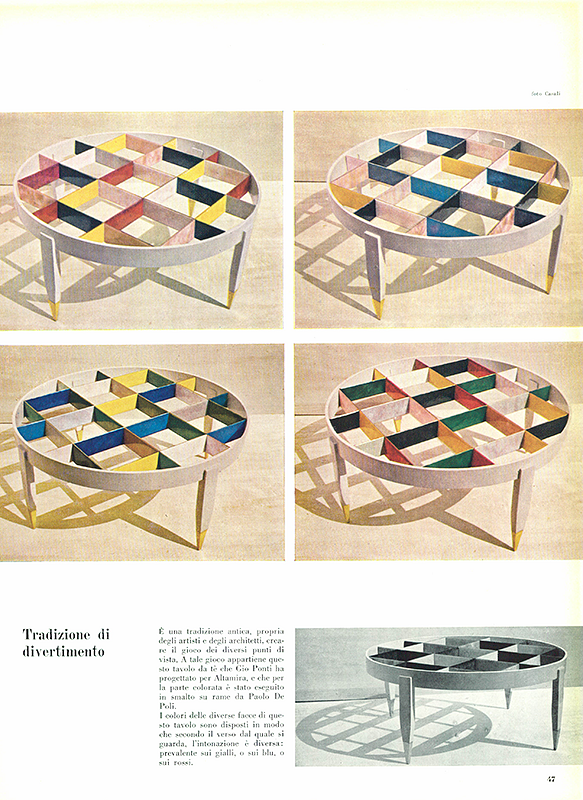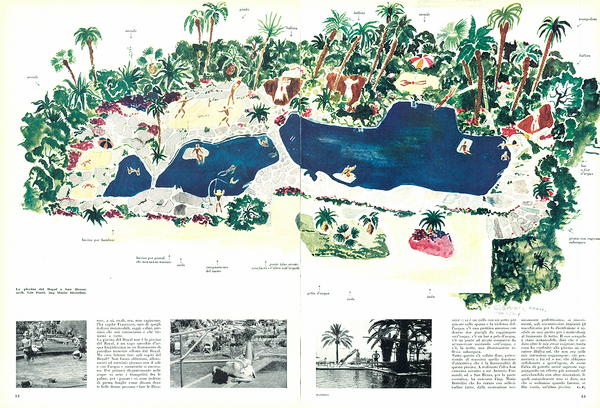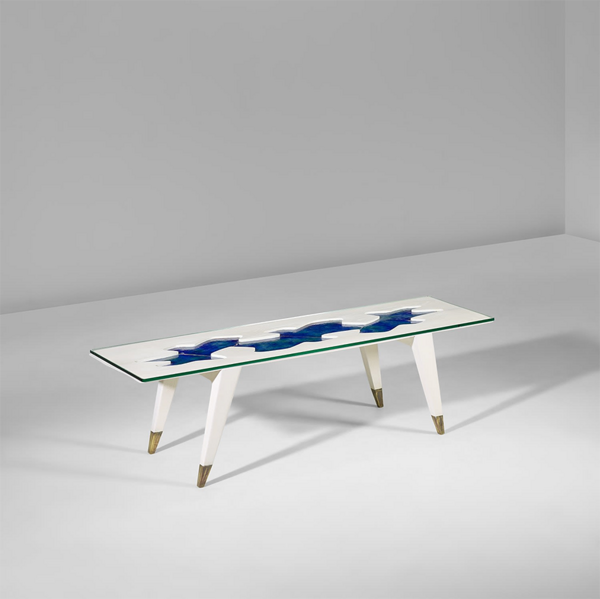Gio Ponti and Paolo De Poli, Unique low table, circa 1955. Design London.
Written by Brian Kish
During the 1950s, Gio Ponti only designed three experimental furniture pieces using Paolo De Poli’s enameled surfaces: two unique coffee tables and one large free-standing fireplace. At first sight it may seem that in these works Ponti is stepping away from his familiar imagery to embrace abstract form. Within the octagonal structure of his fireplace for the villa Namazee in Teheran, however, the surface panels are dappled with blue and white painterly gestures evocative of cloudy skies.
The two coffee tables custom-built within the same twelve months period are both distinctive in intent. The 1954 lattice top table was a prototype made for the Altamira showroom in New York. Here Ponti asked De Poli to devise an enameled copper grid of alternating colors that is evocative of some De Stijl paintings by Mondrian or Van Doesburg.

Gio Ponti’s coffee table prototype for the Altamira showroom in New York, with an enameled copper lattice top design by Paolo De Poli, circa 1954. Images: Archivio Domus - © Editoriale Domus S.p.A.
This unique rectangular table from circa 1955 featured in this auction marks a momentary departure from Ponti’s emblematic tectonics of enhanced structural features toward a design involving pictorial emphasis that is also related to his very own architectural idiosyncrasies. Indeed, the piece seems like a vertical mirroring, that could be a model for his swimming pool projects such as the one for the roof of Hotel Royal in Sanremo.

Gio Ponti’s watercolor drawing of the Hotel Royal swimming pool, Sanremo. Images: Archivio Domus - © Editoriale Domus S.p.A.
Still, both tables have structural features in common such as the white painted wood elements and tapering legs terminating in brass sabots. The rectangular table has a streamlined elevation almost concealing the depth of the massive solid wood slab under the glass top. Ponti relied on his faithful master ebanista Giordano Chiesa to hollow out cavities across the flat-top surface of the wooden slab according to a meandering pattern; he then asked De Poli to fill the voids with his intense ultramarine blue enamel, which turned them into irregular ‘pools’, echoing Ponti’s own words.

Gio Ponti and Paolo De Poli, Unique low table, circa 1955 (detail). Design London.
I hate rectangular swimming pools. Are lakes and rivers rectangular? I want swimming pools for nymphs; And that one dives into from the top of trees; And that have a bar in a cave, reached by swimming underwater
—Gio Ponti
This table project can be seen as a coda to his 1940s Surrealist interiors, where furniture forms were dissolved in Fornasetti patterns, but it also shows Ponti opening up the next chapter where custom design attains the long-sought glow of fine art. In the following decade Ponti achieved an ever-growing autonomy from commerce and industry and contributed to the breakdown of categories between architecture, design, and art, which can also be attributed to the additional momentum of his editorial and curatorial activities. Last but not least, it could be said that these pieces prefigure some experiments developed in 1960s contemporary art projects by Lucio Fontana, Remo Bianco, or Carla Accardi, amongst others.
Brian Kish is a curator and specialist in 20th century Italian architecture and design, and an associate member of the Gio Ponti Archives since 2006.
Recommended Reading
Nanna and Jørgen Ditzel: Nature in Design >
